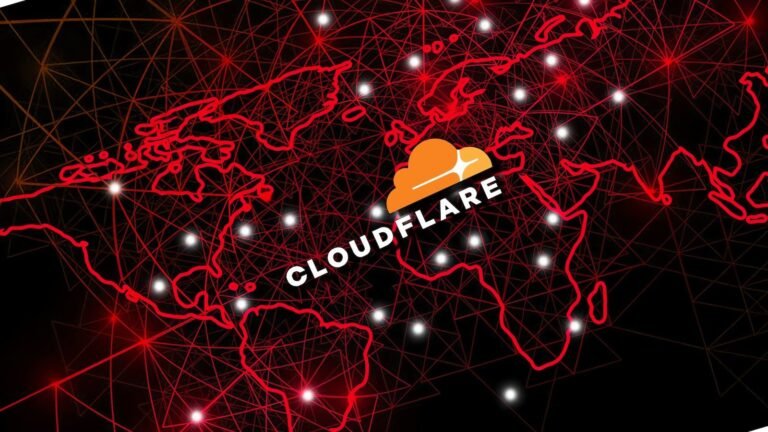Top Highlights
-
Incident Cause: Cloudflare’s 1.1.1.1 Resolver outage on July 14 was due to an internal misconfiguration linked to a future Data Localization Suite, not a cyberattack or BGP hijack, quashing related speculations.
-
Global Impact: The misconfiguration caused widespread internet service interruptions, impacting key DNS IP ranges (1.1.1.1, 1.0.0.1, and their IPv6 counterparts), with a significant drop in DNS traffic observed.
-
Response Timeline: The issue began around 21:48 UTC, was identified by 22:01 UTC, reverted by 22:20 UTC, and services were fully restored by 22:54 UTC, demonstrating a quick but critical response.
- Future Preventive Measures: Cloudflare plans to replace legacy systems with newer ones that allow for progressive rollouts, improved documentation, and better monitoring to prevent similar misconfigurations in the future.
Problem Explained
On July 14, 2023, a worldwide outage of Cloudflare’s 1.1.1.1 DNS Resolver service occurred, affecting countless users and rendering many internet services inaccessible. This disruption originated from an internal misconfiguration rather than a malicious cyber attack or BGP (Border Gateway Protocol) hijack, as speculated on social media. A configuration change for a future Data Localization Suite (DLS), executed on June 6, inadvertently linked the 1.1.1.1 Resolver IP prefixes to an inactive service. A subsequent update on July 14 initiated a refresh of the network configuration, inadvertently routing crucial DNS resources to a non-operational location. As a consequence, traffic to vital IP addresses dropped significantly, prompting Cloudflare to recognize and address the issue within minutes.
Cloudflare promptly communicated the incident, detailing that the misconfiguration had been rectified and full service restoration achieved by 22:54 UTC on the same day. The company also noted that this error could have been averted had it employed a more modern, progressive rollout system, revealing shortcomings in its legacy frameworks. Moving forward, Cloudflare plans to enhance its internal documentation and transition to advanced configuration systems that permit gradual deployment and better monitoring, aiming to mitigate future risks of a similar nature.
Risk Summary
The recent outage of Cloudflare’s 1.1.1.1 Resolver service, attributed to an internal misconfiguration rather than a cyberattack, serves as a stark reminder of the ripple effects such incidents can have on other businesses, users, and organizations reliant on internet infrastructure. When a key public DNS resolver becomes unavailable, it disrupts not just individual users but also hinders the operations of numerous businesses that rely on stable internet connectivity for transactions, communications, and overall functionality. The outage can lead to cascading failures; for instance, e-commerce platforms may experience transaction failures, and remote work operations could face interruptions. The resulting loss of trust can diminish user confidence in digital services, compel organizations to reevaluate their infrastructure dependencies, and potentially drive customers to seek alternatives. Furthermore, the incident underscores the critical need for robust internal controls and documentation practices; stagnation in innovative operational strategies, such as dependency on legacy systems, heightens vulnerability. Should similar misconfigurations occur at any scale, they risk exacerbating the systemic fragility of the interconnected internet ecosystem, making it imperative for organizations to adopt proactive risk management strategies to bolster resilience against such unforeseen disruptions.
Possible Next Steps
Timely remediation is crucial in the realm of cybersecurity incidents, as it directly influences an organization’s risk management posture and operational continuity.
Mitigation Steps
-
Incident Analysis
Assess the nature of the outage and gather data to comprehend the underlying causes. -
Stakeholder Communication
Inform relevant stakeholders, including customers and employees, about the incident and ongoing efforts to rectify it. -
System Check
Conduct comprehensive diagnostics of network systems and borders to ensure no residual vulnerabilities exist. -
Traffic Monitoring
Enable enhanced surveillance on DNS traffic to identify any anomalies or irregular behavior associated with the outage. -
Infrastructure Review
Audit network infrastructure to verify the integrity of routing protocols and configurations, ensuring they align with best practices. - Redundancy Implementation
Consider implementing additional redundancies in DNS infrastructure to minimize future outage impacts.
NIST CSF Guidance
NIST’s Cybersecurity Framework (CSF) emphasizes the importance of identifying and responding to incidents swiftly. Specifically, refer to the "Respond" and "Recover" functions, which underscore the necessity for incident management and communication post-event. For more detailed protocols, the NIST Special Publication 800-61, "Computer Security Incident Handling Guide," should be consulted for best practices in incident response.
Explore More Security Insights
Explore career growth and education via Careers & Learning, or dive into Compliance essentials.
Access world-class cyber research and guidance from IEEE.
Disclaimer: The information provided may not always be accurate or up to date. Please do your own research, as the cybersecurity landscape evolves rapidly. Intended for secondary references purposes only.
Cyberattacks-V1

